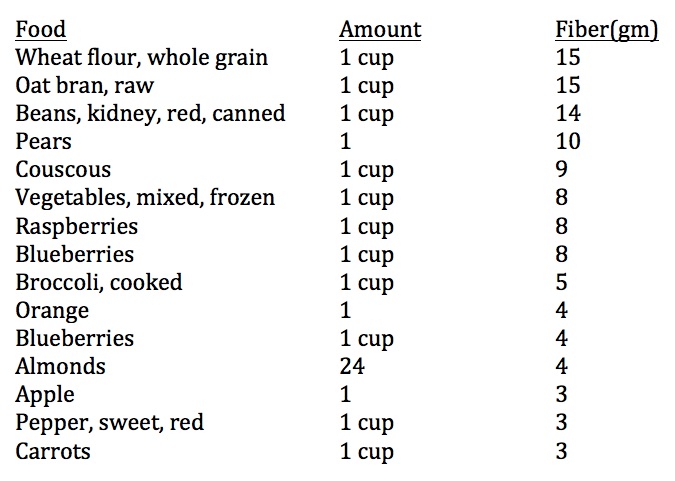Dietary fiber is one of those subjects that most everyone knows is important, but not everybody knows why or even what it is. And who wants to talk about boring old fiber when there are brand new fad diets to try? But from a dietitian’s perspective, and more importantly, a mom’s, I think it’s worth taking a closer look at your dietary fiber needs.
Dietary Fiber: What Is It?
Dietary fiber can be a fairly vague aspect of an individual’s diet. It’s not a vitamin or mineral. It’s not a fat or a protein. Rather it’s a carbohydrate component of many healthy foods found in nature. But the thing about dietary fiber is it’s not digestible.
This is where you may have seen the phrase “Net Carbs” thrown around from time to time. “Net carbs” is a term used in an effort to further classify carbohydrates. It is the total number grams of carbohydrates minus grams of dietary fiber and grams of sugar alcohols.
REMEMBER: Total Carbohydrates – Fiber – Sugar Alcohols = Net Carbs
And because dietary fiber is a carbohydrate that is not digested, it will not raise blood sugar levels. Thus, “net carb” count has become popular in recent years for low-carb dieters. However, science is still unclear concerning “net carbs” and the FDA does not regulate it yet.
Dietary Fiber: Benefits of a High Fiber Diet
An increase in fiber-rich foods can benefit your overall health in many different ways. Dietary fiber can slow down your body’s breakdown of carbohydrates and help control blood sugar. Dietary fiber will even out a “sugar rush,” as well as the inevitable slump after the sugar high. A diet high in fiber has also been credited to increased heart health and decreased risk of stroke.
I have to admit though that my favorite benefit of a diet high in dietary fiber is weight loss and weight management. Because dietary fiber will naturally slow down the digestion process in your body, you will feel fuller for longer periods of time. Can’t argue with that.
RECOMMENDED READING: What’s My Ideal Weight?
Dietary Fiber: How Much Should I Have?
The Institute of Medicine recommends a dietary fiber intake of 25 grams per day for women and 38 grams per day for men. However, Americans typically fall very short of their daily goals, only consuming an average 10-15 grams of dietary fiber a day.
Dietary Fiber: 6 Tips to Increase Your Daily Dose
If you’re falling short, don’t sweat it. Increasing fiber in your diet can be super easy. Make it your goal to eat minimally processed foods. That will help with retaining their fiber content. Here are some other quick suggestions.
1. Pick whole grain food over refined carbohydrates. Not sure how? Read the list of ingredients and avoid any kind of “enriched” grain, especially if it is listed first on the ingredient list.
2. Start your day with a high fiber breakfast. Look for items that will combine to at least 5 grams of fiber and you will be well on your way to a healthy, fiber-rich day.
3. Strive for at least five servings of fresh or frozen fruits and vegetables a day. As you get better and better at making smart food choices, stretch yourself and go for nine servings! Your body will thank you for it.
4. Eat globally. As Americans, we fall short in choosing foods that are high in dietary fiber. But no worries. Get brave and explore other ethnic cuisines. Mexican, Middle-Eastern, and Mediterranean are just a few examples of diets that can be high in dietary fiber.
5. Drink. Drink. Drink. In order for dietary fiber to be processed properly you must maintain optimal hydration. Try to drink at least 8 glasses of water a day. Another good rule of thumb is to drink half your body weight in ounces. And it’s easier than you think if you just keep a glass water bottle nearby. Just drink one full bottle in the morning, noon, evening, and night and you’ll meet most of your goal.
6. Finally, and maybe most importantly, take it slow. If you are one of the many Americans that falls short of your 25-38 grams of dietary fiber a day, don’t make too many drastic changes too quickly. Your body will need time to gradually adjust to the higher fiber diet.
Dietary Fiber: Common Sources
There are many wonderful sources for dietary fiber. It is found in fruits and vegetables, as well as grains and legumes (or beans). It is increasingly being added to processed food to provide some health benefits. Here’s a helpful dietary fiber chart to give you an idea of how and where to get yours.
Dietary Fiber: Can I Supplement?
I know, right? Why not just supplement your dietary fiber with a tablet or even a gummy and call it a day? I get it. I’m busy too. I’ve got four kids running around and the last thing on my mind is “have we met our dietary fiber goal for the day?”
But as a registered dietitian, I would not recommend dietary supplementation for most people. When you are eating a well-rounded diet and pay particular attention to incorporating fresh or frozen fruits and vegetables, as well as legumes and whole grains, then you will naturally meet your fiber goal each day. If you want to know beyond a shadow of a doubt that you are meeting your dietary fiber goal each day, I would recommend keeping a food diary or tracking your nutrition in MyFitnessPal for a few days. If you find yourself falling short of your fiber goals, then tweak your diet and add extra veggies to a meal, snack on some pears, almonds or oranges, and change up your breakfast routine to include some whole grains.
However, if you are still convinced you need to supplement your dietary fiber, be sure to discuss it with your doctor first. Fiber supplementation can interfere with certain drugs and minerals. And don’t forget… drink your water! Otherwise, the supplement could cause a bowel obstruction.
Dietary Fiber: Can I just drink my fiber?
That’s a great question and the short answer is “no!” Let’s consider an apple for our case study. A whole, raw apple with the skin will provide 3 grams of fiber as well as about 60-80 calories. This whole apple will take about 5-10 minutes to bite off, chew, and swallow. In comparison, an 8 ounce glass of apple juice has 120 calories and no dietary fiber and is consumed at a much faster rate than the whole apple. So 50% more calories and no fiber to show for it (plus the risk of added sugars). It may quench your thirst, but my guess is you will still feel hungry and unsatisfied. On the other hand, after you’ve eaten an apple, you have successfully consumed a good amount of free water, slowed your rate of digestion, and lowered your risk of cardiovascular disease, and cancer as well as gastrointestinal conditions such as constipation.
While juicing is a viable option to drink your fruits and vegetables, it will not provide any dietary fiber. However, using a good blender to make whole fruits and vegetables to make smoothies will provide a nutrient dense shake as well as provide additional dietary fiber. Add some Greek yogurt to your smoothie and you have a natural, nutrient dense, high protein, high fiber, energy drink.
TIP: For a great list of 300+ smoothie recipes, check out the Smoothie Wizard. The Smoothie Wizard lets you filter recipes by ingredients you have on hand, rate recipes, add new recipes, and it’s free to use.
Dietary Fiber: Conclusion
So there you have it… a primer on dietary fiber and how to get more of it. Once you start, I think you will see how easy it can be. I step back and marvel at how our Maker has created our bodies to work harmoniously with the earth He created us to inhabit. Yes, our bodies require dietary fiber to stay healthy, but our Lord has provided us plenty of tasty and fun ways for us to meet those fiber requirements. So, friends, go forth and eat well!

